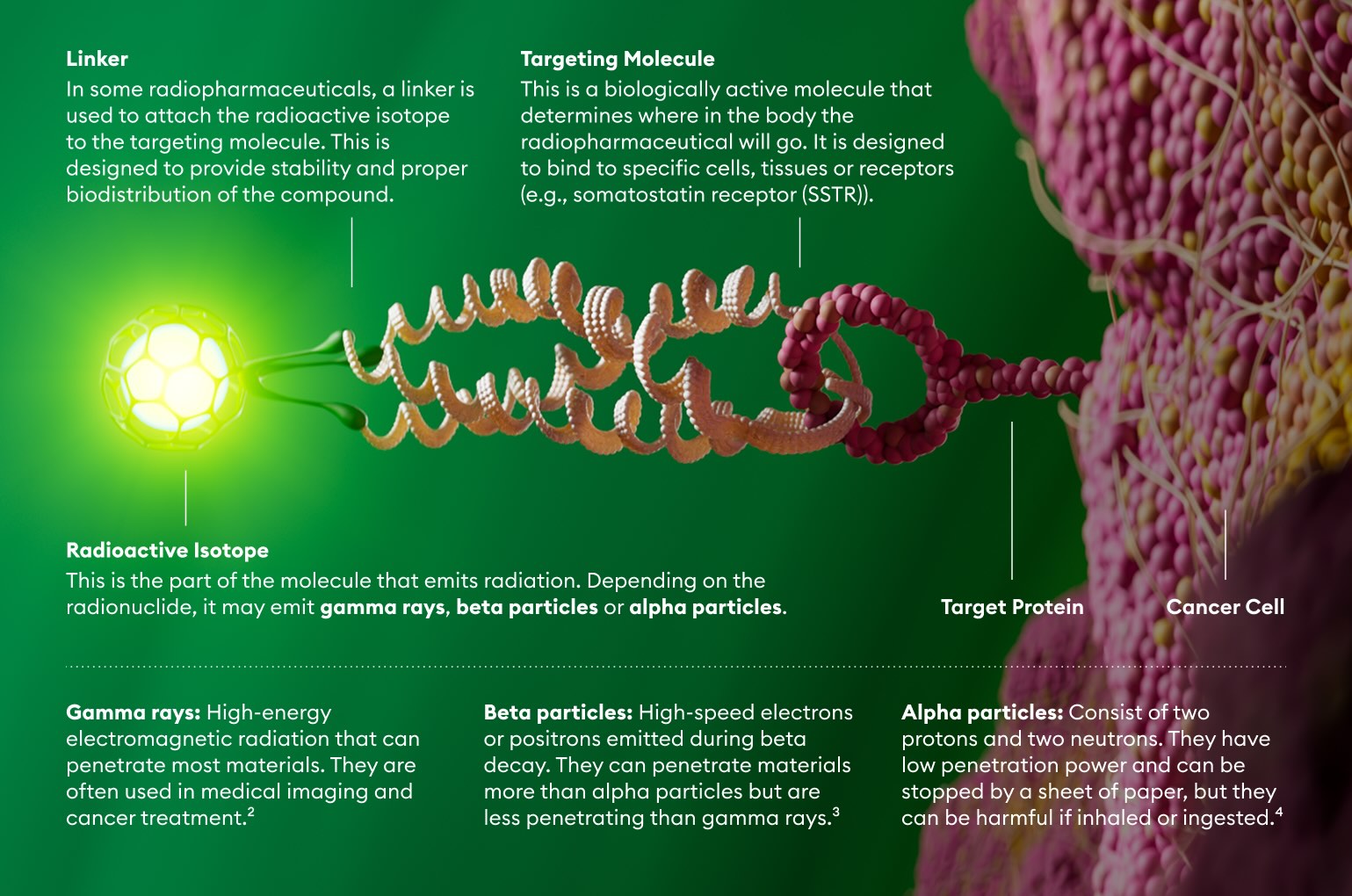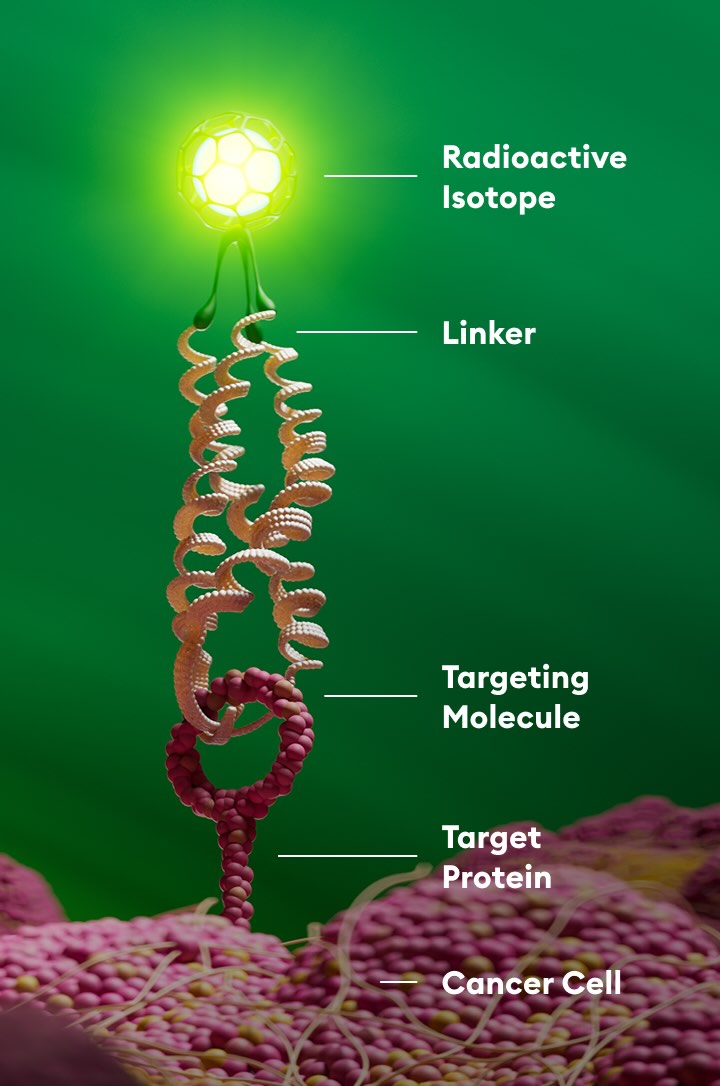Radiopharmaceuticals combine chemistry, biology and nuclear physics to diagnose and treat various medical conditions. While they’ve existed for over a century, scientific advancement is bringing them back into the spotlight.
Understanding radiopharmaceuticals
Radiopharmaceuticals are comprised of three primary components.1


Radioactive Isotope
This is the part of the molecule that emits radiation. Depending on the radionuclide, it may emit gamma rays, beta particles or alpha particles.
Gamma rays: High-energy electromagnetic radiation that can penetrate most materials. They are often used in medical imaging and cancer treatment.2
Beta particles: High-speed electrons or positrons emitted during beta decay. They can penetrate materials more than alpha particles but are less penetrating than gamma rays.3
Alpha particles: Consist of two protons and two neutrons. They have low penetration power and can be stopped by a sheet of paper, but they can be harmful if inhaled or ingested.4
Linker
In some radiopharmaceuticals, a linker is used to attach the radioactive isotope to the targeting molecule. This is designed to provide stability and proper biodistribution of the compound.
Targeting Molecule
This is a biologically active molecule that determines where in the body the radiopharmaceutical will go. It is designed to bind to specific cells, tissues or receptors (e.g., somatostatin receptor (SSTR)).
This structure allows for a highly versatile and customizable product used for different diagnostic and therapeutic applications.
Developed to Find, Fight and Follow® disease
Radiopharmaceuticals are multi-use tools that enable healthcare professionals (HCPs) to support patient care across the entire journey—from diagnosing and staging diseases like cancer or Alzheimer’s disease, to targeting and treating a wide array of tumor types—making them a versatile modality to help improve patient outcomes.

Diagnostic radiopharmaceuticals
These are primarily used in imaging tests to visualize disease. For example, positron emission tomography (PET) scans often use Fluorine-18 (18F).5 18F is a positron-emitting radioisotope of fluorine with a half-life of approximately 110 minutes. It is produced in a cyclotron and is commonly used to label biologically active molecules for diagnostic imaging in oncology, neurology and cardiology.
Therapeutic radiopharmaceuticals
These seek out and bind to cancer cells to deliver a high dose of radiation directly to the tumor while minimizing damage to surrounding healthy tissue. For example, Lutetium-177 (177Lu) is a radioactive isotope of lutetium used in targeted radionuclide therapy for treatment of certain types of cancers. 177Lu is a beta emitter, meaning it emits beta particles that can damage and kill cancer cells.
Theranostic pairs
These combine diagnostic and therapeutic capabilities in a matched pair, using the same or similar targeting molecules to first locate disease and then treat it. For example, a diagnostic scan might use 18F to identify tumors, followed by treatment with 177Lu while targeting the same tumor marker—allowing for personalized, targeted care.
Value and impact on patient outcomes
Radiopharmaceuticals offer several benefits to deliver better patient outcomes6:
Precision in diagnosis and treatment
Radiopharmaceuticals provide accurate diagnostic information, potentially enabling timely and effective treatment interventions of diseases such as cancer, cardiovascular diseases and neurological disorders.
Minimally invasive
Unlike traditional surgical methods, radiopharmaceuticals offer a non-invasive or minimally invasive alternative for both diagnosis and treatment. This can potentially reduce the risk of complications and shorten recovery times.
Superior diagnostic performance
Radiopharmaceuticals offer functional and molecular-level imaging that goes beyond the anatomical detail provided by traditional imaging methods like X-rays or bone scans for potentially more accurate detection of disease.
By harnessing the power of radioactive isotopes, radiopharmaceuticals are not just transforming molecular imaging and treatment—they are paving the way for the next generation of precision medicines that will enable HCPs to better Find, Fight and Follow® disease to deliver better patient outcomes.
References
1. The Chemical Scaffold of Theranostic Radiopharmaceuticals: Radionuclide, Bifunctional Chelator, and Pharmacokinetics Modifying Linker. National Library of Medicine. Published May 10, 2022. Accessed May 21, 2025. https://pubmed.ncbi.nlm.nih.gov/35630536/ 2. Gamma Radiation: Its Discovery, Applications, and Safety Considerations. Open MedScience. Published July 2, 2024. Accessed May 21, 2025. https://openmedscience.com/gamma-radiation-its-discovery-applications-and-safety-considerations/ 3. Beta Particle. Nuclear Power. Accessed May 21, 2025. https://www.nuclear-power.com/nuclear-power/reactor-physics/atomic-nuclear-physics/fundamental-particles/beta-particle/ 4. Properties of Radioactive Isotopes: An Overview. U.S. Centers for Disease Control and Prevention. Published February 22, 2024. Accessed May 21, 2025. https://www.cdc.gov/radiation-health/about/radioactive-isotopes.html 5. Production and Quality Control of Fluorine-18 Labelled Radiopharmaceuticals. International Atomic Energy Agency. Published 2021. Accessed May 21, 2025. https://www.iaea.org/publications/14925/production-and-quality-control-of-fluorine-18-labelled-radiopharmaceuticals 6. Radiopharmaceuticals: Navigating the Frontier of Precision Medicine and Therapeutic Innovation. National Library of Medicine. Published January 5, 2024. Accessed May 21, 2025. https://pubmed.ncbi.nlm.nih.gov/38183131/

